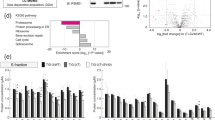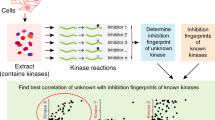Abstract
THE cyclical phosphorylation and dephosphorylation of proteins, catalysed by protein kinases and phosphoprotein phosphatases, respectively, are important ways in which cells regulate many of their metabolic activities. Cells seem to have at least two distinct phosphorylation systems, one in the cytoplasm, the other in the nucleus. The best studied function of the cytoplasmic protein kinases is their mediation of the effects of cyclic AMP in the modulation of existing metabolic pathways, whereas the nuclear protein kinases have been implicated in the regulation of gene activation1. This view is based on the rapid changes in nuclear protein phosphorylation that occur in response to stimuli of differentiation and cell growth2–4, and because phosphorylated proteins are heavily concentrated in the actively transcribed regions of the genome5. For these reasons the nuclear protein kinases have been studied extensively, yet there is very little information concerning their regulation. It is thus of considerable interest to identify the proximal effectors of nuclear protein phosphorylation. We present here evidence for the presence in rat liver nuclei of a 150,000-molecular weight, heat-sensitive inhibitor protein that is specific for the nuclear protein kinases, being without effect on the cytoplasmic enzymes or their subunits. In addition to its potential importance as a negative regulator of nuclear protein kinases, the inhibitor may prove to be a valuable tool in assessing the role of nuclear protein phosphorylation in gene activation.
This is a preview of subscription content, access via your institution
Access options
Subscribe to this journal
Receive 51 print issues and online access
$199.00 per year
only $3.90 per issue
Buy this article
- Purchase on Springer Link
- Instant access to full article PDF
Prices may be subject to local taxes which are calculated during checkout
Similar content being viewed by others
References
Stein, G. S., Spelsberg, T. C. & Kleinsmith, L. J. Science 183, 817–824 (1974).
Kleinsmith, L. J., Allfrey, V. G. & Mirsky, A. E. Science 154, 780–781 (1966).
Ahmed, K. Biochim. biophys. Acta 243, 39–45 (1971).
Jungmann, R. A., Hiestand, P. C. & Schweppe, J. S. Endocrinology 94, 168–183 (1974).
Benjamin, W. B. & Goodman, R. M. Science 166, 629–631 (1969).
Farron-Furstenthal, F. & Lightholder, J. R. in Onco-Developmental Gene Expression (eds Fishman, W. H. & Sell, S.) 57–64 (Academic, New York, 1976).
Farron-Furstenthal, F. & Lightholder, J. R. Biochem. biophys. Res. Commun. 83, 94–100 (1978).
Takeda, M., Yamamura, H. & Ohga, Y. Biochem. biophys. Res. Commun. 42, 1499–1508 (1972).
Ruddon, R. W. & Anderson, S. L. Biochem. biophys. Res. Commun. 46, 1499–1508 (1972).
Kish, V. M. & Kleinsmith, L. J. J. biol. Chem. 249, 750–760 (1974).
Farron-Furstenthal, F. Biochem. biophys. Res. Commun. 67, 307–314 (1975).
Farron-Furstenthal, F. & Lightholder, J. R. FEBS Lett. 84, 313–316 (1977).
Farron-Furstenthal, F. & Lightholder, J. R. Fedn Proc. 36, 793 (1977).
Ashby, C. D. & Walsh, D. A. J. biol. Chem. 247, 6627–6642 (1972).
Author information
Authors and Affiliations
Rights and permissions
About this article
Cite this article
FARRON-FURSTENTHAL, F. An inhibitor protein of nuclear protein kinases. Nature 280, 415–417 (1979). https://doi.org/10.1038/280415a0
Received:
Accepted:
Published:
Issue Date:
DOI: https://doi.org/10.1038/280415a0
This article is cited by
-
Nucleocytoplasmic RNA transport
Molecular and Cellular Biochemistry (1985)
Comments
By submitting a comment you agree to abide by our Terms and Community Guidelines. If you find something abusive or that does not comply with our terms or guidelines please flag it as inappropriate.



